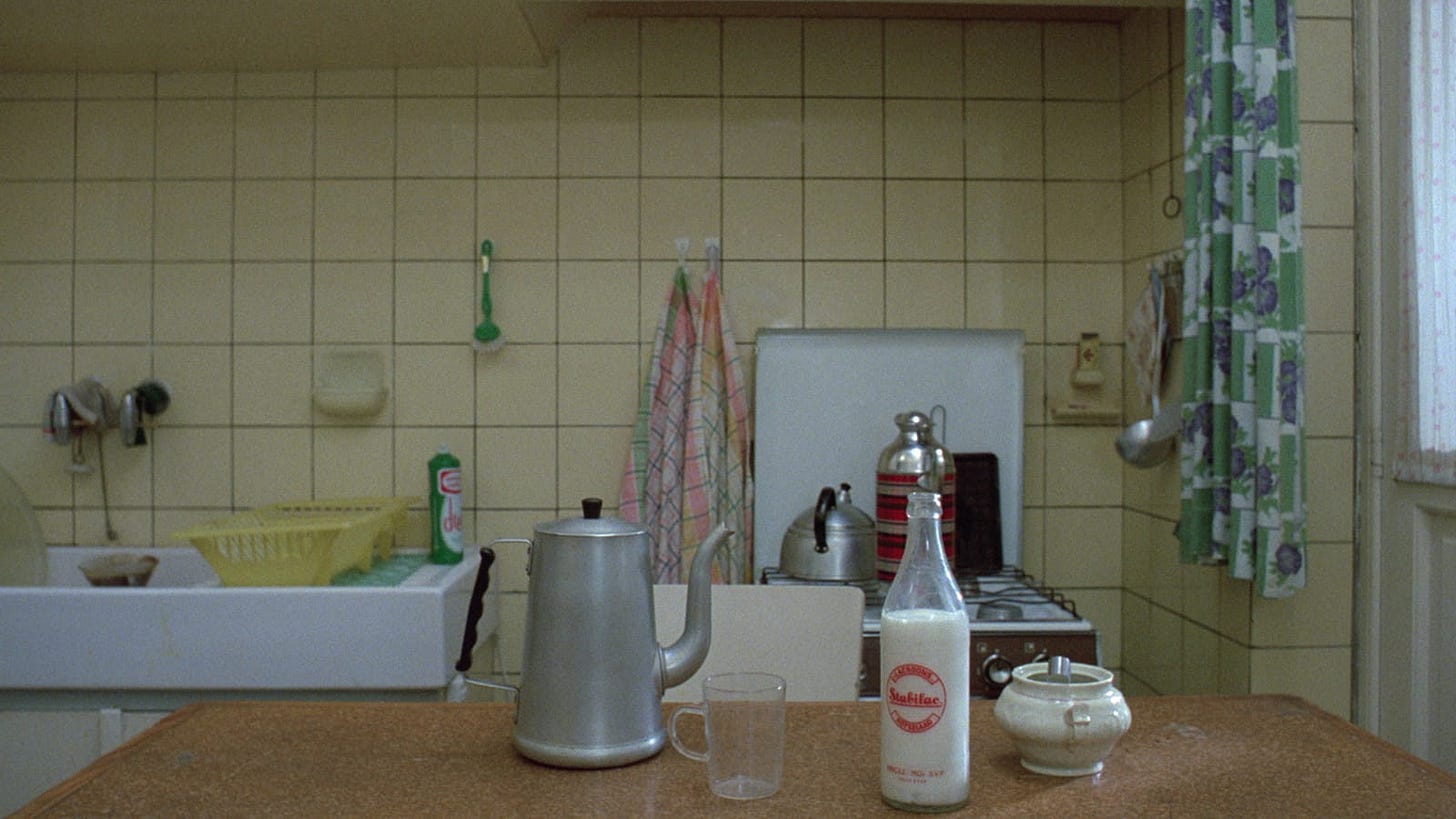To say that I was excited to participate in this year's Sight & Sound poll would be an understatement; it is, in all honesty, one of the coolest things I've gotten to do as a film critic. First launched in 1952 and taking place once a decade ever since, it’s as close to a definitive ranking of the greatest films of all time as we have. Citizen Kane dominated the first several editions, finally being supplanted by Vertigo in 2012, but its reign was short. A new winner has just been crowned: Chantal Akerman’s Jeanne Dielman, 23 quai du Commerce, 1080 Bruxelles — a brilliant, bold, and utterly unexpected choice (it came in 35th last time). Clocking in at over three hours and consisting of little more than its heroine (a brilliant Delphine Seyrig) carrying out daily tasks in real time, it’s the slowest of burns with the most explosive of endings.
I’ll share my own ballot once all 1,639(!) of them are published. For now, here’s a piece I wrote about Jeanne Dielman for a now-defunct outlet in 2011 (were we ever so young?) that probably won’t mind me republishing it:
Though it’s been called the domestic 2001, Chantal Akerman’s Jeanne Dielman, 23, quai du Commerce, 1080 Bruxelles is in my mind more akin to a cinematic desert: Save for a few oases of meaning, the almost unfathomably vast film largely consists of empty space and silence. This, in spite of an overwhelmingly confined milieu: Almost every minute of the film occurs in Jeanne’s apartment, whose address (as well as her name) would be unknown were it not given in the title. The claustrophobic setting has a dual effect insofar as it makes us feel as boxed in as Jeanne does and allows for a character study as intimate as it is distant. Our observations of Jeanne occur over three methodical days — 201 minutes in our time — which proves to be more than enough time to make it exceedingly clear how fastidious she is in carrying out her daily tasks.
Toward this end, Akerman presents exhaustive, no-detail-omitted accounts of Jeanne potato-peeling, sweater-knitting, and shoe-polishing (to name but a few of her many chores), all of it in real time. The meticulousness with which these events are presented is not only a test of viewers’ patience, but a powerful means of drawing attention to Jeanne’s barren internal landscape. The more we watch her do, the more we understand the lost soul she so fundamentally is. As such, what is not being said or shown onscreen is as vital to the complex task of extracting meaning from Jeanne’s routine as what is. Namely: her daily trysts with the men who pay her for sex. For all the “images between images” Akerman portrays, she grants her heroine a measure of privacy in the one aspect of her life that distinguishes Jeanne from most other housewives.
In paying such close attention to the minutiae of this daily routine, Akerman underscores the devastating effects of its minor ruptures. In this way, it’s immediately understood as catastrophic when, on the second day, Jeanne overcooks her potatoes. From this point on, a tension comes to a boil as whatever thread has been keeping her balanced slowly unravels. Not until we are at last allowed a glimpse of Jeanne with one of her clients does this tension resolve itself in an abrupt but seemingly inevitable climax. The contrast between Jeanne's domestic duties and her trick-turning quickly fades as it's made clear that, until now, she herself seems to have conceived of the disparate acts as being cut from the same cloth. And yet one moment changes everything: not only Jeanne herself, but our entire perception of the strange world of which she might as well be the sole inhabitant.
Just as puzzling, perhaps, are the flashes of blue-tinted light that appear on the walls of Jeanne’s dining room. Close but out of reach, the light serves as a near-constant reminder of the alluring outside world of which, despite occasional entrances, Jeanne is not a part. Her world, for all intents and purposes, is a closed system made up of unspoken words, unmet desires. Everything she can’t, won’t, or perhaps doesn’t feel the need to say becomes a stand-in for domestic anomie; her long silences are as telling as her occasional monologues.
In saying so little, however, Jeanne demands attention whenever she speaks — insignificant in her own world, she becomes a dominating presence to her viewers. This paradox is unsurprising, given the film’s contradictory nature: Akerman often tempts the audience to view her film through a particular lens even as she makes any one interpretation of it insufficient. She allows for such a multitude of responses, in fact, that Jeanne Dielman is likely one of the most singularly rewarding — or infuriating, depending on the viewer — experiences ever put on film.
Despite how cold and sterile its surface appears, there is such unspoken sorrow and tension bubbling beneath Jeanne Dielman’s topmost layer as to be teeming with liveliness in a way that underlines cinema’s ability to be more than one thing at once. In such an exacting portrayal of time and space — the film takes up so much of both but offers so little in the way of explicit meaning — Akerman demands that her viewers be as patient as Jeanne is while peeling her potatoes.






